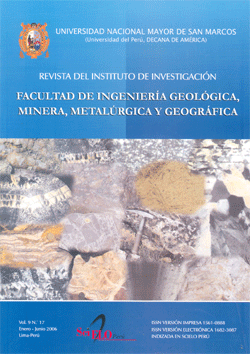Structural characteristics, lead isotopes of gold mineralizations of the border Huaytará- Tantará-Huancavelica (Perú)
DOI:
https://doi.org/10.15381/iigeo.v9i17.644Keywords:
Structural analysis, Phases of deformation, Hydrothermal processes, Lead evolution, Radiogenic lead, Magmatism, Volcanism, CalderaAbstract
The Huaytará-Tantará belt extends along the western flank of the Western Cordillera of the Andes of central Peru. It contains Au-Ag (Pb-Zn-Cu) mineralizations hosted by volcanic sequences from Eocene to Miocene. It is affected by at least six phases of deformation, defined through structural analysis in four work stations: Antapite, Jatun Orcco, Pampa Andino and Castrovirreyna. The diagrams of lead evolution of 17 samples extracted of the three first, indicate hydrothermal processes independent, with a lead evolution similar in Pampa Andino and Jatun Orcco, but different to Antapite. Also, in Antapite the source of radiogenic lead proceed of an orogenic area, with prevalence both the upper crust and the lower crust, contrary to the others zones, that only show influence of the upper crust. Then it is considered that the magmatism of Antapite was deeper and that its fluids had more possibilities of leaching metals from the source. On the other hand, it is considered that the volcanism of the late Eocene related with the Pampa Andino caldera, does not have any relationship with the mineralization of this ore deposit.Downloads
Published
Issue
Section
License
Copyright (c) 2006 Jorge Luis Quispe Cangana

This work is licensed under a Creative Commons Attribution-NonCommercial-ShareAlike 4.0 International License.
AUTHORS RETAIN THEIR RIGHTS:
a. Authors retain their trade mark rights and patent, and also on any process or procedure described in the article.
b. Authors retain their right to share, copy, distribute, perform and publicly communicate their article (eg, to place their article in an institutional repository or publish it in a book), with an acknowledgment of its initial publication in the Rev. Inst. investig. Fac. minas metal cienc. geogr.
c. Authors retain theirs right to make a subsequent publication of their work, to use the article or any part thereof (eg a compilation of his papers, lecture notes, thesis, or a book), always indicating the source of publication (the originator of the work, journal, volume, number and date).






